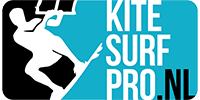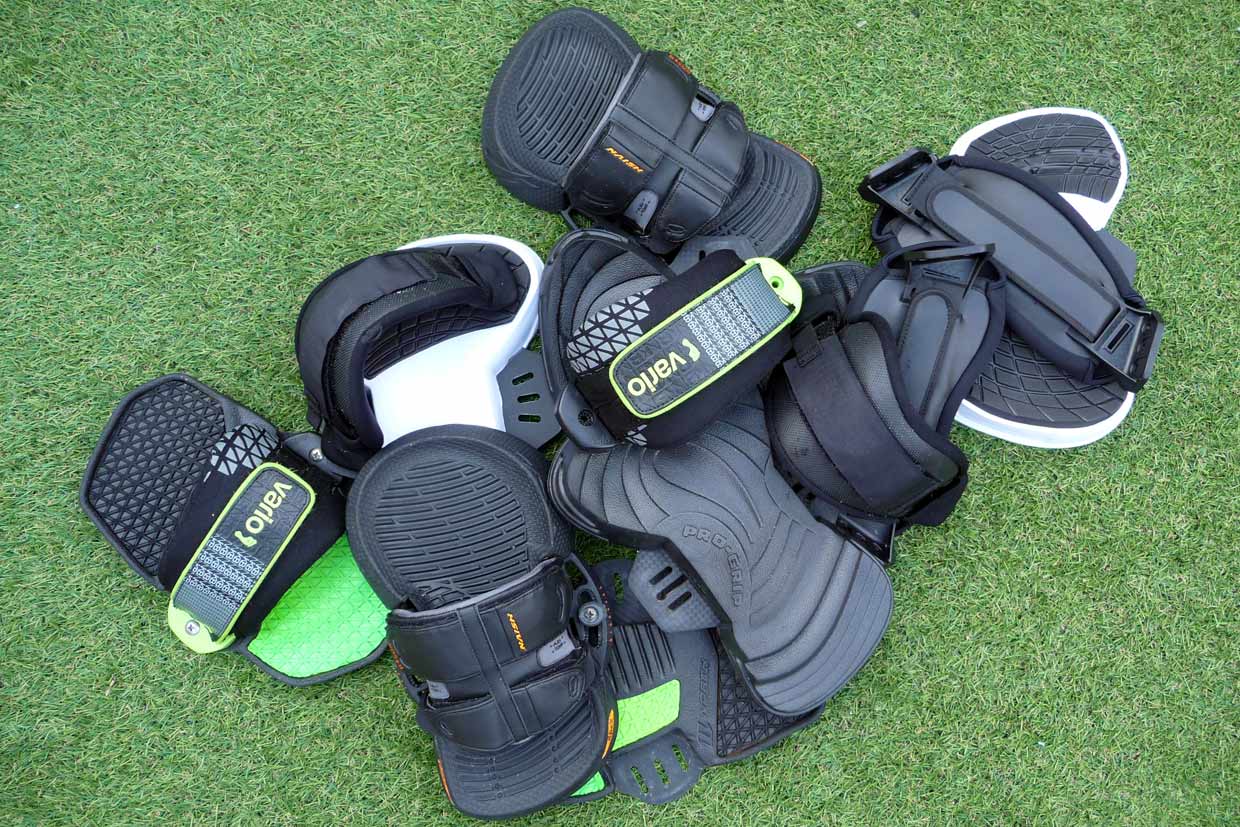Adjusting your twintip kiteboard may seem like a cinch and it is. The actions you have to do are easy and you can do it yourself. However, how you position your kite straps on a twintip kiteboard can make a world of difference when using the kiteboard. Incorrectly placed kiteboard straps can even cause serious injuries. The adjustment of a kiteboard binding is also not universal. There are principles of course, but your own anatomy also plays an important role. In this article 'Foot straps kiteboard' we explain everything about it so that you can adjust your foot straps perfectly.
Content kiteboard bindings
- That is why kite pads and kite straps are needed
- This is how you adjust kiteboard bindings
- Distance between the foot straps
- Position foot straps on the kiteboard
- Angle of the foot straps
- Size foot straps
- Degree of adjustability foot straps
- Cushioning footbed
- Adjusting kiteboard bindings, you cannot escape it
- Consequences of incorrect foot strap size
That is why kite pads and kite straps are needed
You need kite pads and kite straps on a twintip kiteboard. A kite pad is a plate that can be screwed onto the kiteboard with a footbed on top. A kite strap is a foot strap that is attached to the plate with the foot bed. Pads and straps together are also called kiteboard bindings or kiteboard foot straps. A twiptip is a smooth board at the top on which the pads and straps are attached. With the help of kiteboard bindings you do not slide off the board and you can keep a twin tip under control. You can therefore sail fast, make sharp turns and jump high. The bindings also ensure that you do not lose the twin tip on the way. Kite pads and kite straps are therefore crucial.
This is how you adjust kiteboard bindings
Kiteboard bindings can usually be adjusted on a number of points. This depends on the position of the threaded holes in the kiteboard. But it also depends on the plate of the pads themselves to put a screw through that goes into the screw thread of the kiteboard. In addition, the straps can also be adjusted. Sometimes even several points to ensure optimal grip and comfort. There is therefore a lot of quality difference in kiteboard bindings. We will consider this on this page, but first an overview of all the options for adjusting foot straps.
- Distance between foot straps
- Position foot straps on the kiteboard
- Angle foot straps
- Size foot straps
- Width foot straps
- Cushioning foot straps
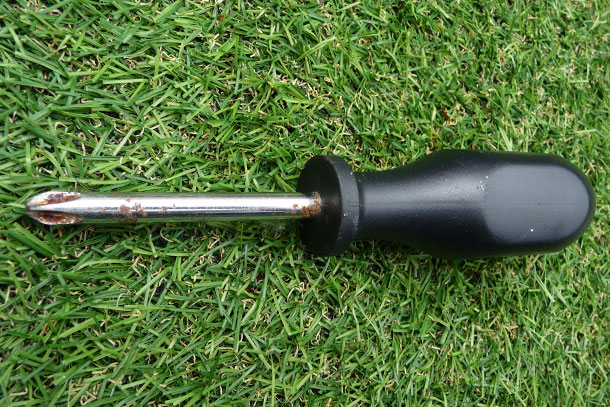
Choose a good screwdriver and tight is tight ...
- If you are going to get started with mounting or changing the setup of the bindings, make sure you have a good, sturdy and suitable screwdriver. One with a thick head with which you can apply good power.
- Fixed is fixed. Preferably you tighten the screws by hand and check the screws after your next session. The screw thread in the kiteboard can take some, but be careful with it and always make it sand-free first.
- Only use the appropriate screws.
- Always have a screwdriver with you when you go kite surfing. Nothing is more annoying than a loose foot strap that you cannot screw on because you do not have a screwdriver with you.
Distance between the foot straps
With the distance between the foot straps we mean how many centimeters the foot straps are apart. You can choose from 3 positions on almost all kiteboards. From a wider position to a narrower position. The distance that you can choose based on the thread in the kiteboard is between 43 and 55 cm. Then we are talking about the screw thread on the inside to which the plate of the foot strap is attached. The distance between the center of the footbed to the center of the other footpath is then of course greater.
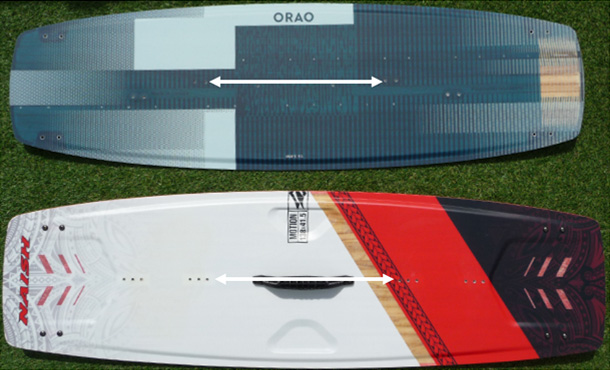
On the example it has Decathlon Orao kiteboard two options: 43 cm or 48 cm apart. It Naish Motion kiteboard has three options: 45 cm, 49 cm or 53 cm apart.
Starting points for distance foot straps
Length partly determines 'small stance' or 'wide stance'
- In general, it can be said that longer kite surfers, with longer legs, have the foot straps a little further apart. So the middle or wider position.
- On the other hand, shorter kite surfers with shorter legs have the foot straps narrower. So the narrower position.
- In between, there is usually still the middle class. So for kite surfers of average length.
Your ideal stand? Create a squad
Another way to get behind your natural position is to jump forward and land in the so-called low squad position. You do this by jumping forward and landing in a comfortable squatting position with the knees at an angle of about 90 degrees. How your feet are on landing is a natural position for you. The width also gives a good indication of how far apart your feet should be.
Foot straps further apart ('wide stance')
- When the bindings are wider, the pressure points of the feet are different and the board is therefore less flexible to very stiff. This puts more strain on the legs and knees.
- Foot straps further apart helps to hold more strength. Because the kite surfing is more towards the ends of the kiteboard, the ends of the kiteboard are automatically kept low. This provides stability.
- Kite surfers who do a lot of freestyle and wakestyle tricks and therefore want to build up more pressure for tricks and land these harder, the kiteboard bindings are often wide. This also provides more stability when landing tricks.
- Foot straps further apart make the board less flexible and the tips stay lower. This makes it less suitable for beautiful curves and in the waves. The tips will go through the water and bite more often.
Foot straps closer together ('small stance')
- If the bindings are narrower, the pressure points of the feet are different and the board is therefore more flexible. The pressure then comes more from the center, so that the kiteboard can be optimally flexible. This is less stressful for the knees.
- With a narrower stand and more pressure from the center, the flexibility of the kiteboard can do its job. This way the tips go up more and you can kite surf more easily through the waves without the tip being pushed under water.
- A narrower position makes the kiteboard feel more playful. The board is easier to steer, for example to make turns from heel side to toe side and ride waves.
- Foot straps too close together reduces stability when landing tricks. The kite surfer gets off balance more easily. Rotations, on the other hand, are easier and faster.
Conclusion distance between the foot straps
You have now been able to read all the information and let it affect you. Based on this information, you can determine the ideal distance between the foot straps for you. Our last tip is to try it out for yourself now that you know the basics. Kitesurf agree with the foot strap as close together as possible, on the middle position and as far apart as possible. You will be able to see the difference very well.
Position foot straps on the kiteboard
With the position of foot straps on the kiteboard we mean the distance from the back of the foot strap to the edge of the kiteboard. With a standard twintip kiteboard, the screw thread is placed off-center so that the heel side is almost above the rail of the kiteboard. You can then only mount your foot straps on one side of the board.
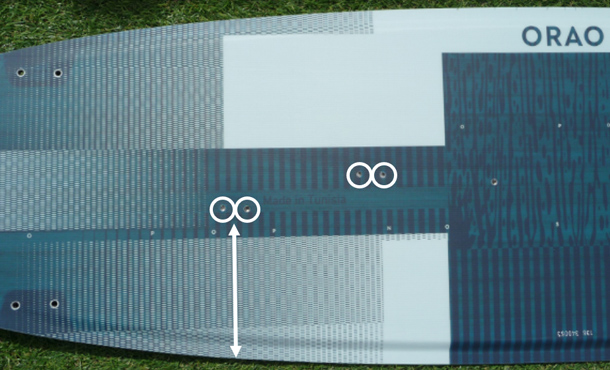
This is very well visible with light wind twintips. These kiteboard are a lot wider than normal and therefore the foot straps should be further off the center. We explain why below. There are also twin tips that have the screw thread exactly in the middle of the kiteboard. The idea is that when the rail of the board starts to wear out on one side, the foot straps can also be placed on the other side.
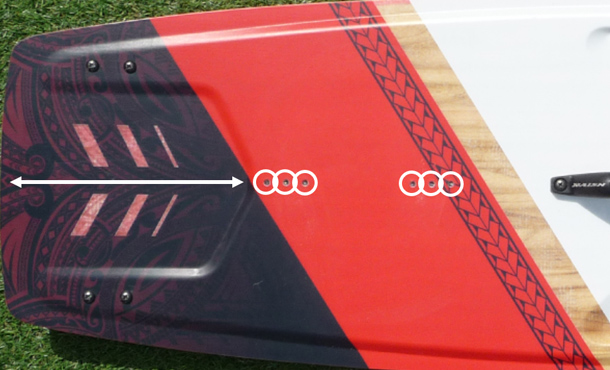
These kinds of boards place a lot of demands on the adjustment options of the plate on which the foot straps are attached. And even though these adjustment options are widely available, these types of boards are not suitable for every kite surfer. For example, kite surfers with a small foot. Think of ladies and children† According to the principles below, it is possible that the foot straps cannot be placed correctly.
Starting points for the position of feeding belts on the kiteboard
- The closer your foot is with the heel side against the rail of the kiteboard, the harder you can edge. By sides we mean putting pressure on the rail of the kiteboard.
- You have to be able to edging and thus put pressure on the rail of the kiteboard. This is necessary to be able to race, to convert power on the board into speed and course with more wind.
- You also need to be able to make jumps.
- If the wind blows less, you also need to be able to keep the kiteboard a bit flatter and therefore push it a bit more in the middle of the board. The kiteboard must then go a bit more flat over the water, whereby the grip of the board and the fins must help to be able to race.
- Also for curves and toeside kite surfing it is nicer if the foot straps are slightly more to the center.
- It may be that when a kite surfer has pain in his shin, the foot straps are too much to the center. Then the toes are continuously pulled up to be able to bend.
- To land jumps, it is nice that the pressure on landing does not press directly on the rail of the kiteboard. Also called an 'off center' landing. This can be prevented by not racing immediately upon landing, but landing a little more upwind with the board flat.
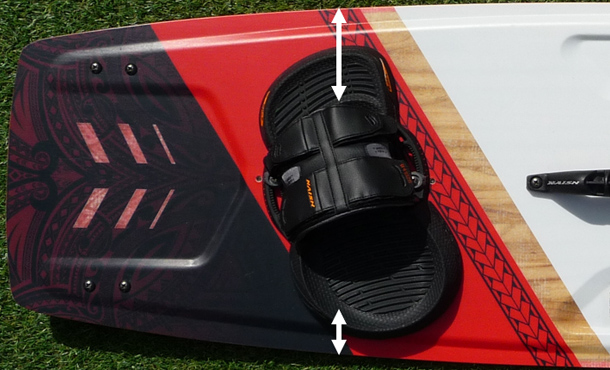
Smaller foot
Kitesurfers with a smaller foot as well ladies and children with a small foot size, preferably choose a less wide kiteboard. This way they can also place the foot straps in such a way that the heel side is more against the edge of the kiteboard. This helps them to put good pressure on the edges, but also to be able to turn corners and kitesurf toeside.
Consideration when buying kiteboard and foot straps
The advice is to pay attention to the important things for you when purchasing a kiteboard. If the kiteboard binding cannot be adjusted in a way that supports you, then it is simply not suitable.
Angle of the foot straps
By the angle of the foot straps we mean the slope of the toes to the outside of the kiteboard. Foot straps can be placed at right angles to the board. This is called 'parallel stance'. Foot straps can also be placed on the board at an angle. This is called 'duck footed stance'.
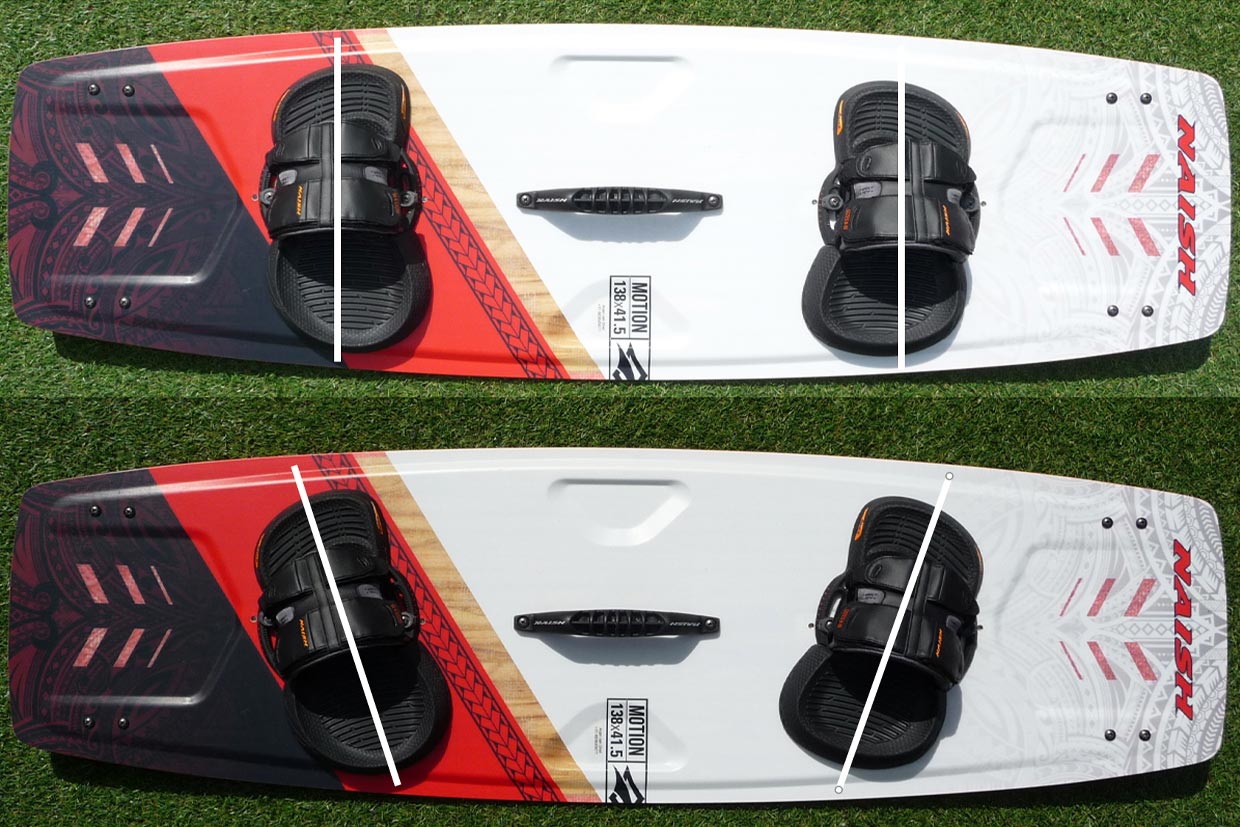
Starting points angle of the foot straps
- Foot straps adjusted with the toes pointing more outward ('duck footed stance') is the most natural position for many kite surfers.
- With a position too little 'duck footed stance' you can lose your kiteboard more easily because you are pulled sideways from the foot straps.
- If you want to go kite surfing, the hips must be turned in the direction in which the kite surfer kitesurf. It helps if the foot straps are turned. The turned front foot ensures that the hips are turned in. In this way the board twists and can be sailed wonderfully. The board then glides smoothly over waves and the kite surfer does not get a lot of splashes in his face.
- With the foot straps angled, the hips turned in and the front leg a little more stretched, the kite surfer has a nice open posture and kitesurfing is a lot smoother.
- Duck footed stance also helps to make many different movements. Think of turning curves and 'toe side' kite surfing.
- Too far 'duck footed stance' is also possible. This can cause pain on the inside of the knee. Moreover, with 'duck footed stance' you always have one foot that is not in the sailing direction. This is the back foot. This can cause problems with that knee during a hard landing.
- A more upright position of the foot straps basically provides more stability when landing tricks and the finer turning of rotations like 360 and freestyle tricks.
The ideal angle for you in two steps
You must discover for yourself the angle this is ideal for you. One option to do this is to jump into the air and land in the crouched squad position (knees bent 90 degrees). The angle of your feet when landing gives a good indication of your natural posture. Another option is to look at your feet in the foot straps while kite surfing. Is your foot more with the toes inwards compared to the foot strap? Then your foot strap could be slightly moved inwards. Is your foot more with the toes out in relation to the football association? Then your foot strap could be slightly moved outwards.
Being able to move your foot slightly during kite surfing
In addition, it is important that your feet are tight in the foot straps but not too tight. A kite surfer must be able to turn his feet once in the foot straps. This helps with kite surfing so that the foot can give optimal pressure at the moment. Sometimes the foot turned in a little more, sometimes a little less. Sometimes a bit more pressure on the forefoot and toes, sometimes more on the heels or flat. This is of course not possible with kiteboard bindings with a fixed shoe ('boat'). That is why an intermediate position is often chosen for kiteboard bindings with 'boots'. Not straight but not too oblique either.
Size foot straps
You can buy foot straps and the plate with the footbed on which the straps are mounted in different sizes. Not every set of foot straps is available in different sizes. The best sets do and this is sometimes crucial. Just like with normal shoes, the footbed of a foot strap makes a big difference. In addition, with a footbed for foot straps, it is the case that it largely determines whether your foot does not pop out of the foot strap at the slightest bit. A footbed with a shape that fits your foot is therefore quite important. It prevents cramps in your foot and provides a lot of extra grip. Finally, nothing is more annoying than a footbed that is too small and your heel protrudes over the edge of the footbed. This quickly becomes very irritating.
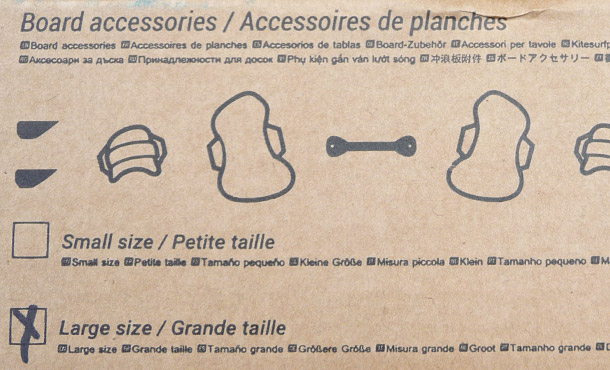
Degree of adjustability foot straps
The more points you can adjust a foot strap, the better it is. Precisely because you can adjust the foot strap in such a way that it fits well around your instep and the grip is optimal. Some types of foot straps can thus be adjusted in four places: on both sides at the toes and on both sides at the top of the instep. But it does not mean that only these top models are recommended. Foot straps with a large preformed strap on the top generally connect well enough for a lot of kitesurfing fun.
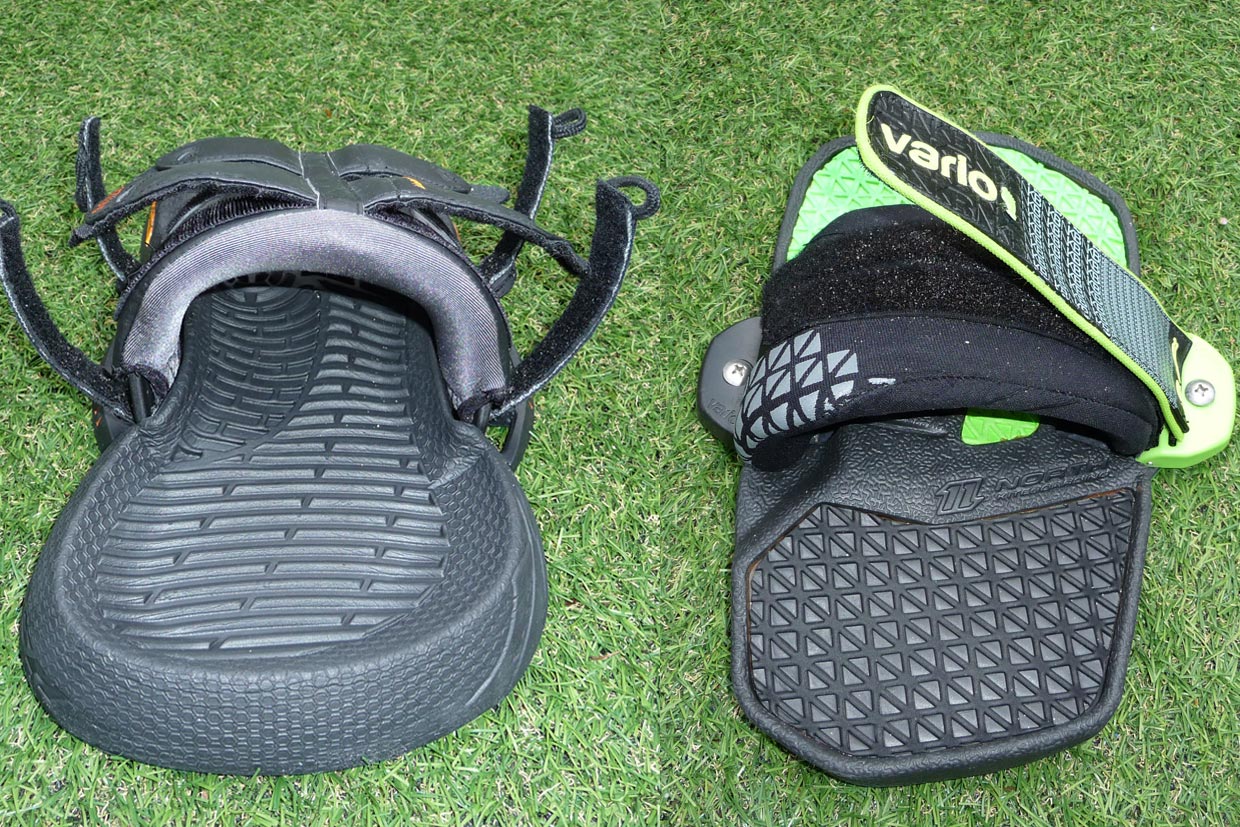
Cushioning footbed
Some foot pads provide less cushioning than other foot straps. There are also foot pads for which you can adjust the damping. You can then opt for more attenuation, but also for less attenuation. For example, if you have a stiff kiteboard but still want to relieve your knees, a footbed that offers a lot of cushioning can be a solution. But also vice versa. If you have a board that is very flexible, a harder footbed can work well and strengthen your board feeling.
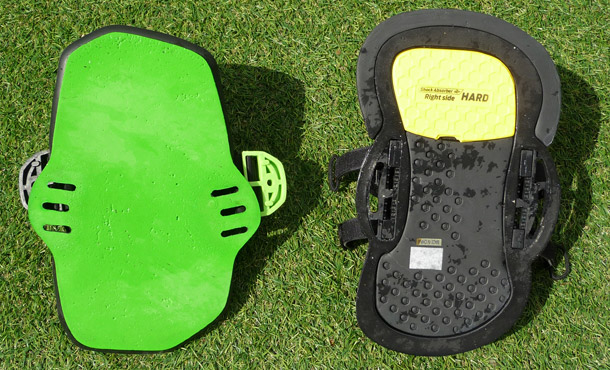
Adjusting kiteboard bindings, you cannot escape it
- Because of the seasons: shoes on, shoes off
- In the Netherlands we have seasons that cause us considerable temperature differences. That is why every kite surfer kitesurfs in the winter with neoprene shoes on. You may also wear neoprene shoes in the summer. For example, if you go kite surfing on a kite spot with stones or a lot of shells on the bottom. This way you cannot avoid regularly readjusting your foot straps.
- Due to wind conditions: a lot of wind, little wind
- It can be very nice to loosen your foot straps in less wind. This way your feet have more freedom of movement to keep your kiteboard more flat on the water and to get going. Or if the wind dips for a moment to keep your kiteboard a bit flatter and use the fins more to walk height. With more wind it is nicer if the foot straps are a bit tighter. You will then tire less quickly, you can give better counter pressure to the kite and harder & longer sides for loading a jump. It is worth experimenting with this.
Consequences of incorrect foot strap size
An incorrect foot strap size is likely to give your feet little or too much grip in the foot straps. The preformed footbed then does not fit the shape of your foot properly. It is also possible that the foot straps cannot be optimally adjusted. This can lead to muscle pain, cramps and a forced posture. Ultimately, this can lead to injuries and / or a less enjoyable kitesurfing session. For example, you easily lose your kiteboard, kite surf uncontrollably and / or tricks do not work. There is no perfect setup for every kite surfer. You have to figure it out yourself based on your own anatomy. Hopefully, the tools in this article will help you very well. Good luck mounting and adjusting your foot straps.
